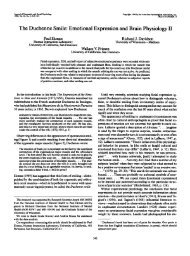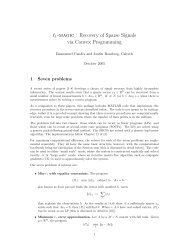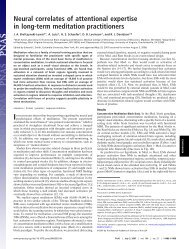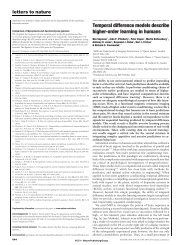Deconvolution Analysis of FMRI Time Series Data - Waisman ...
Deconvolution Analysis of FMRI Time Series Data - Waisman ...
Deconvolution Analysis of FMRI Time Series Data - Waisman ...
Create successful ePaper yourself
Turn your PDF publications into a flip-book with our unique Google optimized e-Paper software.
-errts eprexThe optional -errts command instructs program 3dDeconvolve to save the residual errors(i.e., error = data - full model t) into an AFNI 3d+time dataset. The output dataset hasprex lename eprex.If -errts is used in conjunction with the -input1D command, then the single residualerror time series will be written to le eprex.1D. Note: This will automatically overwritea pre-existing eprex.1D le.-bucket bprexThe -bucket command is used to create a single AFNI \bucket" type dataset havingmultiple sub-bricks. The output is written to the le with the user specied prex lenamebprex. Each <strong>of</strong> the individual sub-bricks can then be accessed for display within programafni. The purpose <strong>of</strong> this command is to simplify le management, since most <strong>of</strong> the outputresults for a particular problem can now becontained within a single AFNI bucket dataset.See Examples 1.4.2.5, 1.4.3.6, 1.4.4.6, and 1.4.6.5 for illustrations <strong>of</strong> the format <strong>of</strong> the bucketdataset.The following commands control the contents <strong>of</strong> the output bucket dataset:-fout Flag to output the partial- and full model F-statistics-rout Flag to output the partial- and full model R 2-tout Flag to output the t-statistic for each regression parameter-vout Flag to output the sample variance (MSE) map-nocout Flag to suppress output <strong>of</strong> the regression coecients(and associated statistics)-full rst Flag to specify that the full model statistics willappear rst in the bucket dataset output1.4 Examples1.4.1 Evaluation <strong>of</strong> the Experimental DesignIn the following Examples, we consider evaluation <strong>of</strong> the experimental design prior tocollecting data. This is done by using the -nodata option in place <strong>of</strong> the -input command.Example 1.4.1.1 Evaluation <strong>of</strong> a Block DesignSuppose that we wish to evaluate a \block" type design, with a repeating stimuluspattern <strong>of</strong> 4 \O" TR, followed by 4\On"TR,as indicated below.f(t) = f 0 0 0 0 1 1 1 1 0 0 0 0 1 1 1 1 0 0 0 01 1 1 1 0 0 0 0 1 1 1 1 0 0 0 0 1 1 1 10 0 0 0 1 1 1 1 0 0 0 0 1 1 1 1 0 0 0 0 gSave the above f(t), one row at a time, as a single column <strong>of</strong> 0's and 1's into leBlock.1D. Suppose that we wish to estimate the system IRF for 0-4 TR's. Consider thefollowing script:25




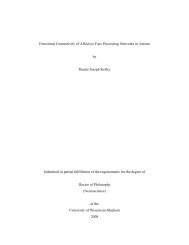
![[F-18]-L-DOPA PET scan shows loss of dopaminergic neurons](https://img.yumpu.com/41721684/1/190x146/f-18-l-dopa-pet-scan-shows-loss-of-dopaminergic-neurons.jpg?quality=85)
